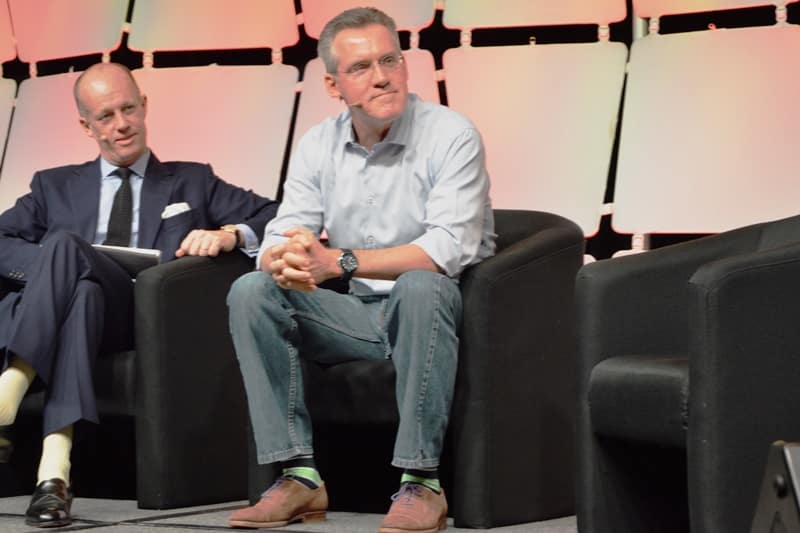
This week is the third annual EmTech Asia, a gathering of technology innovators, scientists, researchers, and investors. The event opened with a speech from Mr. Steve Leonard, IDA Executive Deputy Chairman, who helped describe how technology disruption affects society and the collaborative nature of Singapore’s Smart Nation vision.
Steve Leonard started out by discussing how far technology has come, with respect to maturity level, and how it continues to disrupt our everyday lives. The telegraph is a prime example of this disruption as it transmitted information in a matter of just minutes.
“When you think of the massive disruption that this represents, in terms of moving information, bringing ideas and knowledge, and bringing us closer together, that is a huge disruption. I can argue that not many technologies have had such a huge disruption in quite a while,” said Steve Leonard.
Dealing with today’s issues through Collaboration
Singapore is hosting a place, for researchers, start-ups, universities, and corporations, to work on tough problems which plague society today, and may have lasting effects on our future.
Recognising that there are many issues that society deals with today, Mr. Leonard emphasised that this is why we need people to come together. Only then will we be addressing these issues through such innovative collaboration.
Health care concerns due to the spread of infectious diseases, such as the zika virus and dengue fever, are causing quite the stir right now. On the same token, antibiotic resistance is increasing.
In this decline of new discoveries and increase in resistance, support for research and innovation will drive the outcome of solutions.
“This is where Smart Nation was imagined,” stated Mr. Leonard.
A key objective of Smart Nation is to facilitate collaboration; this includes better sharing of data. This will enable organisations to develop a better understanding of their data’s value.
Public and private sector agencies are becoming more open to the idea of disclosing shareable data. With this, Mr. Leonard argues that they must also be comfortable with the idea of privacy and protecting the value of the data- only then will there be useful insights.
To expand on these concerns, Mr. Leonard poses the following question to the audience, “How do we balance the privacy of citizens, privacy of data, with the ability to still make some meaningful use out of data?”
In Singapore, these are some of the challenges which multiple committees, groups, and agencies are dealt with. This takes us back to recent remarks by Dr. Vivian Balakrishnan, Singapore’s Minister for Foreign Affairs and the Minister-in-charge of the Smart Nation Programme Office, who advocates for data sharing platforms, such as www.data.gov.sg.
“It is not a technical question, but it is a political and cultural issue. In Singapore, we have a government that is obsessed with rectitude, integrity, and with trustworthiness,” said Dr. Balakrishnan, “But the champion for open data in Singapore is our Prime Minister. He is badgering every single government agency, and a lot of efforts are being paid towards making this data available through APIs.”
Singapore’s Future Landscape
Steve Leonard describes Smart Nation as a long journey for Singapore. It was only a year ago that Smart Nation was announced, and already it has set ambitious plans.
One of its key objectives is to achieve full connectivity for all people, machines, and things. “We are trying to make sure everything and everyone, everywhere…is connected. This would create pervasive connectivity,” stated Mr. Leonard.
Following this remark, Mr. Leonard took to twitter to recognise these high aspirations.
Easy to say – so hard to do. But future (health, transport, energy) needs *perfect* connectivity https://t.co/geJ7L1xTz1
— Steve Leonard (@steveleonardSG) January 26, 2016
While sitting on stage, the acting moderator asked Mr. Leonard what he imagines Singapore’s future landscape to be. The reason for asking this was because Singapore is often seen as a regional haven for innovative stimulation and brilliance- leaving outsiders astonished at how far the nation has come in the past 50 years.
Mr. Leonard argued that the future landscape of Singapore will be defined through technology. In the same ways that our lives were transformed by trains, new technologies and research will first disrupt and then change the routine of our daily lives.
“The big challenge for us is not technology… the big challenge for us will be other parts of the ecosystems,” exclaimed Mr. Leonard,
“Part of this starts with adoption, asking if we are comfortable to do these things knowing they won’t always work out right… The challenge for any government is to know that sometimes those things won’t work out but the citizens are counting on them to make sure there are no problems.”
Trying to integrate new, unfamiliar, and innovative technologies into a nation, will surely disrupt the environment. In listening to Mr. Leonard’s remarks, it is clear that there will always be strong reactions to change.
But the nation of Singapore can only move forward with its Smart Nation vision if it continues to challenge the ‘status quo’, Mr. Leonard tells us that ‘this is why we need to keep pushing’.

















